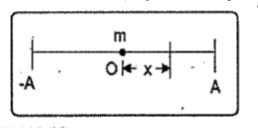Derive the equation for the kinetic energy and potential energy of a simple harmonic oscillator and show that the total energy of a particle in simple harmonic motion is constant at any given point on its path.
Text Solution
Expression for K.E of a simple harmonic oscillator : The displacement of the body in S.H.M, X = A sinωt
where A = amplitude and ωr = Angular displacement.
Velocity at any instant, v = dxdt=Aωcosωt
So its K.E = 12mv2=12mA2ω2cos2ωt
But cos2ωt=(1−sin2ωt)
∴K.E=12mA2ω2(1−sin2ωt)
=12mA2ω2(1−sin2ωt)
=12mA2ω2[1−x2A2]
=12mω2[A2−x2]
∴K.E=12mω2[A2−x2]
At mean position velocity is maximum and displacement x = 0
∴K.Emax=12mA2ω2
Expression for P.E. of a simple harmonic oscillator : Let a body of mass .m. in S.H.M with an amplitude A

Let O is the mean position.
Equation of a body in S.H.M is given by x = A sinωt
Force, F=ma=−mω2x
Restoring force , F = mω2x
Potential energy of the body ay any point say .x. : Let the body is displaced through a small distance dx
⇒ Work done, dW = F dx
This work done = P.E. in the body
∴ P.E. = mω2 x. dx(where x is its displacement)
Total work done, W = ∫dW=∫x0mω2x.dx
work done W = mω2x22
This work is stored as potential energy.
∴ P.E. at any point = 12mω2x2
For conservation force total Mechanical Energy at any point
= E = P.E + K.E
∴ Total energy,
E=12mω2(A2−x2)+12mω2x2
∴E=12mω2{A2−x2+x2}=12mω2A2
Sor For a body in S.H.M total energy at any point of its motion is constant and equals to 12mω2A2
|
Topper's Solved these Questions
Similar Questions
Knowledge Check
The total energy of a simple harmonic oscillation is proportional to
AamplitudeBsquare of amplitudeCfrequencyDvelocityA particle is executing simple harmonic motion. Its total energy is proportional to its
Adisplacement from equilibrium positionBfrequency of oscillationCsquare of amplitude of motionDvelocity at equilibrium positionA particle is executing simple harmonic motion .Its total energy is proportional to its -
Adisplacement from equilibrium positionBfrequency of oscillationCsquare of amplitude of motionDvelocity at equilibrium position
The average kinetic energy of a simple harmonic oscillator is 2 joule and its total energy is 5 joule. Its minimum potential energy is
View SolutionIf the total energy of a simple harmonic oscillator is E, then its potential energy, when it is halfway to its endpoint will be
View SolutionThe kinetic energy and potential energy of a particle executing simple harmonic motion will be equal when displacement (amplitude = a) is
View SolutionThe kinetic energy and potential energy of a particle executing simple harmonic motion will be equal, when displacement (amplitude =a) is
View SolutionThe total energy of a particle having a displacement x, executing simple harmonic motion is
View Solution
